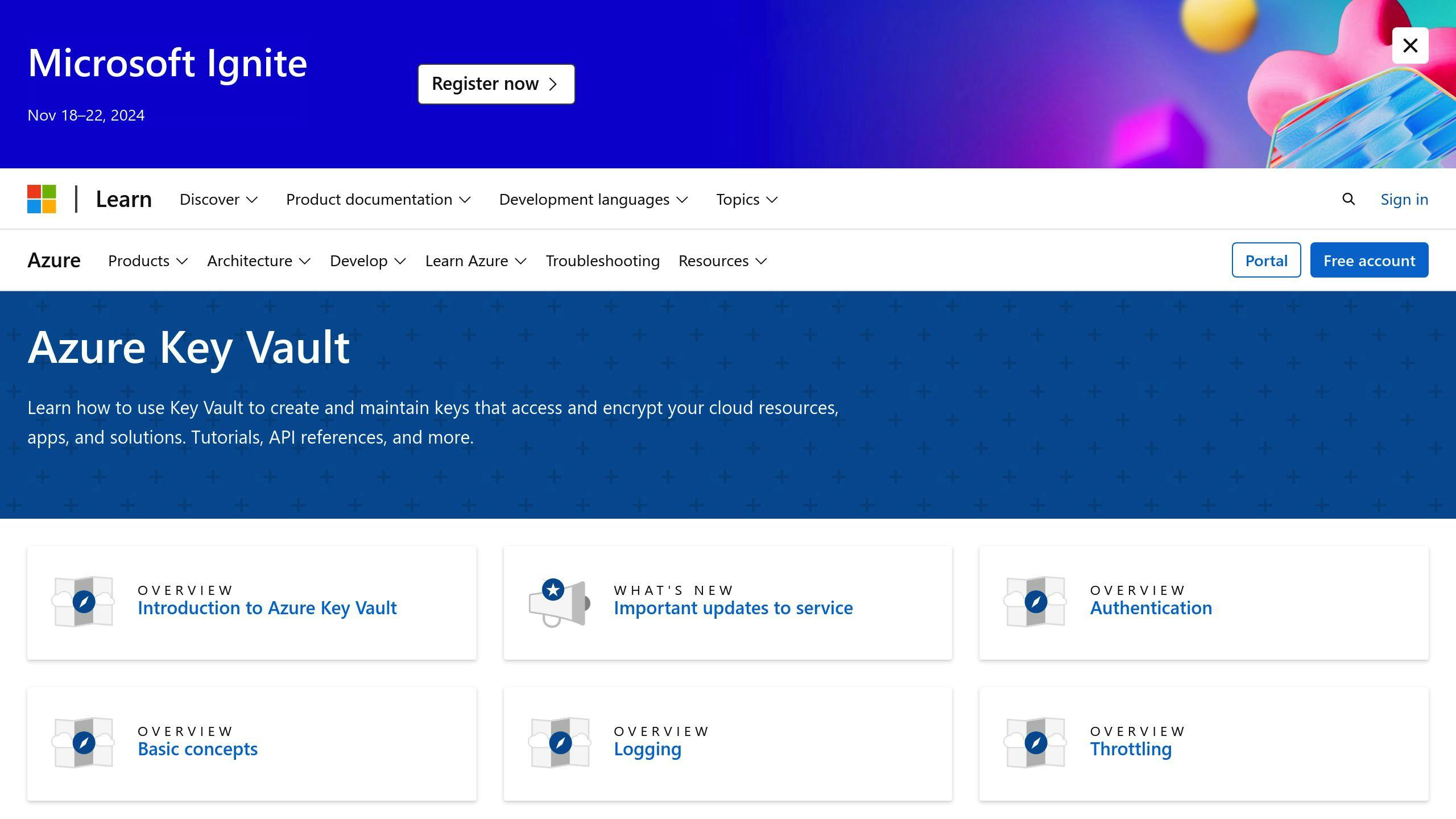Want to keep your Azure Key Vault secure? Start with logging. Here's what you need to know:
- Turn on full logging
- Store logs correctly
- Watch logs in real-time
- Check logs often
- Limit who can access logs
- Keep logs safe when sending
- Do regular log reviews
Key takeaways:
- Logging is like a security camera for your digital vault
- It helps spot unusual behavior and keeps you compliant
- Azure Key Vault logging captures all authenticated REST API requests
Here's a quick comparison of logging methods:
| Method | Ease of Use | Detail Level | Real-time Monitoring |
|---|---|---|---|
| Azure CLI | Easy | High | No |
| PowerShell | Moderate | High | No |
| Azure Portal | Very Easy | Medium | Yes |
| Azure Monitor | Moderate | Very High | Yes |
Remember: What you don't know about your Key Vault can hurt you. Log it, watch it, stay safe.
Related video from YouTube
Turn on Full Logging
First up: enable full logging for your Azure Key Vault. It's like activating all your security cameras - you want to catch everything.
Here's the process:
- Find your Key Vault's resource ID
- Choose a log destination (Azure Storage or Log Analytics)
- Enable logging via Azure CLI, PowerShell, or Azure portal
Let's break it down:
Azure CLI:
az monitor diagnostic-settings create --resource <your-key-vault-resource-id> --storage-account <your-storage-account-id> --logs "[{category:AuditEvent,enabled:true}]"
This command starts logging all audit events for your Key Vault.
PowerShell:
Set-AzDiagnosticSetting -ResourceId <your-key-vault-resource-id> -StorageAccountId <your-storage-account-id> -Enabled $true -Category AuditEvent -RetentionEnabled $true -RetentionInDays 365
This script enables logging and sets a one-year retention policy.
Pro tip: Want to keep logs forever? Set retention to 0 days. But remember: more logs = higher storage costs.
After enabling logging, Azure creates an insights-logs-auditevent container in your storage account for Key Vault logs.
"To monitor access to your secrets and their lifecycle, turn on Key Vault logging", says Microsoft's official docs.
Logging captures all authenticated REST API requests, including:
- Vault creation/deletion
- Access policy changes
- Key and secret operations
- Failed requests (crucial for spotting potential breaches)
2. Store Logs Correctly
Storing Azure Key Vault logs properly is key for monitoring and security. Here's how:
1. Pick the right storage account
Your storage account must be in the same subscription as your Key Vault. This keeps things running smoothly.
2. Set up logging with PowerShell
Use this PowerShell command to enable logging:
Set-AzDiagnosticSetting -ResourceId $keyvault.ResourceId -storageAccountId $storageaccount.Id -Enabled $true -Category AuditEvent -RetentionEnabled $true -RetentionInDays 365
This turns on audit event logging with a 365-day retention policy.
3. Set your retention policy
Stick to 365 days for standard compliance. Need to keep logs forever? Set retention days to 0.
4. Find your logs
Azure creates an insights-logs-auditevent container in your storage account. Your Key Vault logs are there as JSON text blobs.
5. Lock down your logs
Use Azure's access controls to limit who can see your storage account. It's an extra security layer for your sensitive log data.
| Log Field | What It Means |
|---|---|
| time | When it happened (UTC) |
| resourceId | Which Key Vault |
| operationName | What was done |
| resultType | How the API request went |
| callerIpAddress | Who did it |
You can usually access logs about 10 minutes after a Key Vault operation. Sometimes even faster.
3. Watch Logs in Real-time
Real-time log monitoring is crucial for quick issue detection in Azure Key Vault. Here's how:
1. Use Azure Monitor
Azure Monitor is your key tool for real-time log watching. It shows your Key Vault's health, performance, and security at a glance.
To set it up:
- Open Azure portal
- Click "Monitor" in the left sidebar
- Select "Key Vaults" under "Insights"
You'll see a dashboard with key metrics for all your vaults.
2. Set Up Custom Alerts
Don't want to watch dashboards 24/7? Set up alerts:
- In Azure Monitor, click "Alerts"
- Create a new rule
- Choose your Key Vault
- Set conditions (e.g., failed requests > 10 in 5 minutes)
- Pick your notification method
| Alert Type | Use Case |
|---|---|
| Static | Fixed threshold (e.g., > 100 requests/minute) |
| Dynamic | Unusual behavior based on past data |
3. Enable Diagnostic Settings
For deeper log insights:
- Open your Key Vault in Azure portal
- Click "Diagnostic settings"
- Create a new setting
- Send logs to Log Analytics workspace
This allows you to query logs using Kusto Query Language (KQL).
4. Use Key Vault Insights
Key Vault Insights in Azure Monitor gives you a unified view of your vault's performance:
- Go to Azure Monitor
- Click "Insights" > "Key Vaults"
- Pick your subscription and time range
You'll see interactive charts for requests, latency, and failures across all vaults.
4. Check Logs Often
Keeping tabs on your Azure Key Vault logs is crucial. Here's why and how:
Why it matters:
- Spot weird activities
- Catch potential security risks
- Stay in line with your company's rules
How to do it right:
1. Use Azure Monitor
Azure Monitor is your best friend for log analysis. It gathers data from every corner of your system.
Here's how:
- Open Azure portal
- Go to "Monitor"
- Click "Logs"
- Run queries to dig into your Key Vault data
2. Make it a habit
Don't just check logs when you feel like it. Set a schedule and stick to it.
3. Know what to look for
Focus on these key events:
| Event Type | Red Flags |
|---|---|
| Access attempts | Weird logins or failures |
| Secret operations | New secrets, changes, or deletions |
| Key operations | Unusual usage, unexpected tweaks |
| Certificate events | Expiring certs, renewal hiccups |
4. Turn on data plane auditing
This captures ALL the juicy details. But heads up: it's not on by default.
5. Leverage Azure Log Analytics
For the nitty-gritty:
- Set up diagnostics flow
- Get raw data from all activities
- Run complex queries to zoom in on specific events
Regular log checks aren't just about playing defense. They help you understand your Key Vault's usage, spot issues early, and keep things running smoothly.
sbb-itb-29cd4f6
5. Limit Who Can Access Logs
Securing your Azure Key Vault logs is crucial. Here's how to lock it down:
1. Use Azure RBAC
Azure Role-Based Access Control is your go-to for managing log access. It lets you control who sees logs and set permissions at different levels.
2. Create custom roles
Don't stick to built-in roles. Make your own:
| Role Name | Permissions |
|---|---|
| Log Viewer | Read-only access |
| Log Analyst | Read and analyze |
| Log Manager | Full control |
3. Implement Just-in-Time access
Use Azure AD Privileged Identity Management to grant temporary access, require approval, and enforce multi-factor authentication.
4. Audit access regularly
Keep an eye on who's accessing your logs. Review monthly, look for odd patterns, and revoke unnecessary permissions.
5. Separate duties
Don't give one person all the power. Split log management tasks and assign different roles to team members.
6. Keep Logs Safe When Sending
Sending logs isn't just a copy-paste job. You need to lock them down. Here's how to keep your Azure Key Vault logs secure during transit:
1. Use HTTPS
Always use HTTPS for sending logs. Azure Storage REST API calls MUST be over HTTPS when secure transfer is required. It's on by default for new storage accounts.
2. Encrypt with Customer-Managed Keys (CMK)
Don't rely on Microsoft-managed keys. Use your own:
| Step | Action |
|---|---|
| 1 | Create a user-assigned identity |
| 2 | Grant it access to your Azure Key Vault |
| 3 | Configure storage to use CMK |
This puts you in control of key access.
3. Set Up TLS 1.3
Use at least TLS 1.3 for your agent. It's the most secure version. But don't lock it down too tight:
"It's better not to force your agent to only use TLS 1.3 unless you have to. Let the agent automatically detect and use future security standards."
4. Choose Secure Destinations
When enabling logging, pick safe spots:
- Azure storage account
- Log Analytics workspace
5. Set Up Alerts
Keep tabs on your logs:
"Set up alerts for 'All Administrative operations' on your vaults. This way, you'll know about any changes."
This helps you spot if someone's messing with your logs.
7. Do Regular Log Reviews
Log reviews are your window into Azure Key Vault activity. Here's how to make them effective:
1. Set a Schedule
Don't wait for problems. Stick to a routine:
| Frequency | Focus |
|---|---|
| Daily | Unusual access, failed attempts |
| Weekly | New users, permission changes |
| Monthly | Usage trends, policy compliance |
2. Use Azure Log Analytics
Dig deeper with queries like:
AzureDiagnostics
| where ResourceType == "VAULTS"
| where OperationName == "VaultGet" or OperationName == "VaultPut"
| summarize count() by OperationName, ResultType
This shows who's accessing your vault and if they succeed.
3. Check Both Planes
Monitor management plane (vault settings changes) and data plane (secret access) logs.
4. Automate Alerts
Set up alerts for critical events. Microsoft recommends:
"Set up alerts for 'All Administrative operations' on your vaults. This way, you'll know about any changes."
5. Act on Findings
Make your reviews count:
| Finding | Action |
|---|---|
| Odd access times | Update access policies if needed |
| Failed logins | Check for brute force attempts |
| Secret retrieval spikes | Review and optimize app behavior |
Conclusion
Azure Key Vault is crucial for cloud security. But without logging, you're flying blind.
Here's the deal:
Logging is your security camera. It records everything happening in your vault - who's looking at secrets, who's changing access.
But it's not a set-it-and-forget-it thing. You need to:
- Keep an eye on those logs
- Set up alerts for suspicious activity
- Check them regularly
Good logging does more than catch bad actors. It helps you:
- Find inefficiencies in how your apps use secrets
- Stay compliant
- Understand usage patterns
It's a team effort. Security, dev, and ops all play a part. Share what you learn and keep improving.
Yes, setting up logging takes time. But it's way cheaper than dealing with a breach.
Bottom line: With Azure Key Vault, what you don't know can bite you. So log it, watch it, and stay safe.
FAQs
How to audit Azure Key Vault?

Here's how to audit Azure Key Vault:
1. Turn on logging
Use this PowerShell script:
$kv = Get-AzKeyVault -VaultName "<your key vault name>"
$sa = New-AzStorageAccount -ResourceGroupName $kv.ResourceGroupName -Name ('keyvaultlogs4' + $kv.VaultName) -Type Standard_LRS -Location $kv.Location
Set-AzDiagnosticSetting -ResourceId $kv.ResourceId -StorageAccountId $sa.Id -Enabled $true -Category AuditEvent
2. Wait 20 minutes for logs to show up in your storage account.
3. Find logs in the insights-logs-auditevent container.
4. Get and check logs using Azure CLI:
az storage blob list
Then download and review.
How do I monitor key vault in Azure?
To monitor Azure Key Vault:
- Go to Azure Portal
- Click "Monitor" (left menu)
- Pick "Key Vaults" under Insights
You'll see an Overview workbook with:
| Metric | What it means |
|---|---|
| Total requests | API calls to your vault |
| Average latency | Response speed |
| Success ratio | % of successful requests |
Blue values in API hits columns? Pay attention.
Pro tip: Set alerts for weird activity, like logins from non-Azure IPs.
Management plane activities? Check 'AzureActivity' table. Data plane stuff? Look in 'AzureDiagnostics'.


